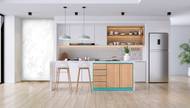If you’re practicing social distancing (and really, who isn’t?), that likely means more time at home, and maybe more free time. And what’s the thing we always say we’ll get to when we have more free time? Home improvement.
At press time, Nevada hardware stores and nurseries remained open during the shutdown. So let’s begin. Once you’re finished replacing air filters and the batteries in your smoke alarms, here are five relatively easy projects, whether you’re a crafter, a complete menace with tools or somewhere in between.
Install a low-flow showerhead
Generally, this means unscrewing one shower head and screwing in another. Use an adjustable wrench to get it started; it should unscrew easily after that. Wrap Teflon tape (also called plumber’s tape) around the joint, screw on the new head and tighten well with a wrench to avoid leaks. You can replace either the shower head or both the head and the arm (the same general principles apply).
Paint the bathroom
You’ll probably need to block off a couple of days for this to allow enough drying time. If possible, choose a paint specifically meant for a high-humidity area (semi-gloss is best). Tape off mirrors, vanity, toilet, tub and trim with a good, easy-to-remove painter’s tape. Remove decor and electrical plates.
Priming first is recommended; otherwise you might need to paint twice to even out the color. Turn on the fan or open the windows (paint fumes are stinky and can cause irritation to mucus membranes). Wait the recommended time between coats, replace decor and electrical plates and voila! … a new bathroom.
Install vinyl plank flooring
There are two types of vinyl plank flooring, a peel-and-stick version and a click-and-lock version. Both are water-resistant, making them good for bathrooms, laundries and kitchens, as well as main living areas. For both, you’ll need a utility knife to score and cut planks (and for click-and-lock, a rubber mallet and block help).
These installations can be finished in a day over existing flooring for small areas, although larger areas might take a day or two longer. Carefully measure the area in which you’ll be installing, and add 20 percent to that (mess-ups are inevitable).
Paint the kitchen cabinets with chalk paint
Chalk paint was popularized during the 1990s by Annie Sloan, who developed it to paint furniture. Today, Home Depot sells several brands. Pick up a gallon, plus wax and a wax brush to finish it off, and you’ll probably be able to do the whole kitchen in a couple of days. The glory of chalk paint is that you don’t have to sand or strip. Cabinets in pretty good shape might just need a light cleaning with soap and water. Tape around the cabinets, and start painting with a soft brush.
You’ll need to apply multiple coats, but this paint dries so quickly, you’ll be able to repaint in minutes. Wax it by working a small amount evenly all over the surface and into crevices. Let cure a day and add another coat of wax, then buff with a soft cloth. The waxing is pretty important, as it will help protect cabinets from staining. Chalk painting and waxing will create fumes, so make sure the area is well-ventilated.
Plant a garden
One popular method popularized by author Mel Bartholomew is called square foot gardening, whereby a small plot is divided into equal squares, and each one is planted with a separate type of vegetable or herbs. This works well for either existing raised beds or new ones you make yourself.
One easy method is to buy four planter blocks and insert 2-inch-wide-by-6-inch-tall wooden boards between the slots. Fill with soil to about an inch from the top. You’ll need several bags of garden soil and potting mix, depending on the size of the bed. Two feet wide is the minimum, but don’t make it more than four, since you want to be able to reach each plant area without stepping into the bed.
Mark off the bed in squares and plant with compatible species (a quick web search will help you figure that part out). If you can’t build a raised bed, try planting at least 10-inch-wide containers with vegetables, and group them closely to emulate the concept.







